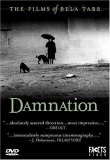| Reviews & Columns |
|
Reviews DVD TV on DVD Blu-ray 4K UHD International DVDs In Theaters Reviews by Studio Video Games Features Collector Series DVDs Easter Egg Database Interviews DVD Talk Radio Feature Articles Columns Anime Talk DVD Savant Horror DVDs The M.O.D. Squad Art House HD Talk Silent DVD
|
DVD Talk Forum |
|
|
| Resources |
|
DVD Price Search Customer Service #'s RCE Info Links |
|
Columns
|
|
|
Damnation
THE MOVIE:
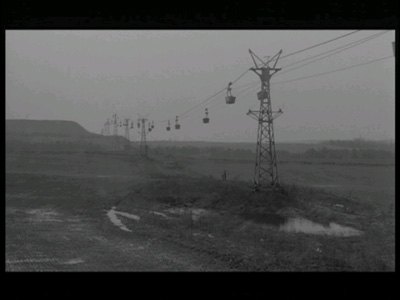
Hungarian filmmaker Béla Tarr, along with his script collaborator Laszlo Krasznahorkai, knows a little bit about patience. Patience is at the core of his craft and is also essential to understanding a film like Damnation (Kárhozat; 1988). This is not to say that Damnation is tedious, because it's quite the contrary. For all of its quiet moments and its near-glacial pace, it never ceases to involve its viewer--all because of the gift of patience.
Karrer (Miklós Székely) is a broken man living in an isolated industrial town. Cut off from the outside world, he is trapped within its borders. Large metal buckets travel along overhead cables carrying things he cannot see to places he cannot go, and he watches them longingly, as if they would transport him out of the purgatory he inhabits beneath them. They are always there, and when they can't be seen, they are heard through the grind of metal and the metronomic tick they create. In watching them, Karrer is like the movie's audience--a spectator to something outside of himself that moves according to its own pace. If he lets the buckets go, perhaps they will reveal to him the secret he is missing. So it is the same for watching Damnation: let the scenes play out, let the characters go about their business, and a reward awaits you.
I called it a "purgatory" because the setting of Damnation is indeed a sort of middle state. It could merely be a metaphor for life, which itself is what we do in between birth and death, when we wait for something else to come along. Yet, there are also higher metaphors here. Karrer is pulled from two sides, between the longing of his spirit to be free, and the longing of his body that ties him to the cabaret singer he lusts for. Similarly, there are two polar influences at work on his conscience. First there is Willarski (Gyula Pauer), the dark-haired owner of the local bar. His establishment has been aptly named Titanik, and he is always there to listen to a man who wants to talk about himself, indulging the individual's selfish desires before luring lost souls into crime. Second is the white-haired older woman who works in the club's coat room (Hédi Temessy), protecting the outer shells her clients use to protect themselves. She doesn't listen, but instead proclaims. Whenever the coat-check woman arrives, she has words of advice for Karrer. In at least one case, they actually come from the Bible. Yet, for as positive as they may be intended to sound, they often sound like judgments.
Karrer sees an opening when his Beelzebub offers him a job smuggling goods. Rather than take it himself--he feels he is not allowed to leave the area--he offers it to the husband (György Cserhalmi) of the singer at the club (Vali Kerekes), knowing the man's debts will force him to take it. When the husband is out of town, he can make a move on the wife, whom Karrer loves. On his return, however, the husband will give Karrer his final piece of advice: "There's always a chance to escape. There can be cracks in the fabric of things." Like the old woman's speeches, this ends up sounding more like a threat than it does a design for life. Words are important to how people perceive themselves. More than once, Karrer refers to life as a story, one that any individual can close the book on any time they want, starting over again on a new page. Yet, since when have participants of any story been their own construct, capable of their own action? Mustn't they always wait for some larger force to enact change? The other way is the way of hubris.
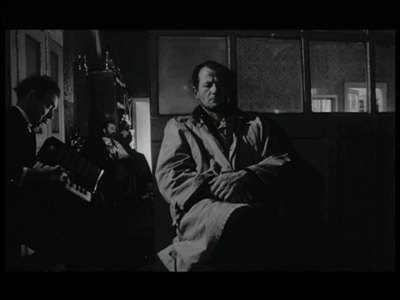
Music also plays a central roll in Damnation. Through most of the film, the tunes are quiet and sad, sparse instrumentation and plaintive vocals representing the absence of feeling. As the movie reaches its climax, the music speeds up, representing the lack of control Karrer's actions have created. In fact, all the characters are being punished for the actions they have taken. That is the illusion of their lives: they dream of getting out, but the more they try, the less patient they are, the more stuck they become. The betrayal of music is of particular irony to the singer, who dreams of going to another city and being famous. As the dance escalates, the humiliation she suffers--and it involves her precious throat, even--is possibly the worst. Everyone else at the Titanik follows the band, dancing themselves into a happy oblivion while Karrer and company sit the revelry out in order to forge ahead with their own undoing.
Béla Tarr uses his camera to show us how inextricably linked his characters are to their environment. Taking a cue from the Antonioni of L'eclisse, he often leaves the central action, slowly panning away from his characters to look at a broken fence or an empty wall. The people are as dilapidated as the village they have built, and just as the buildings wait for repairs, the viewer waits for the camera to find its way back again. There is a constant layer of rain on everything, and dogs roam the streets of their own accord. It's as if everything is out of balance. In fact, when Karrer is finally off the deep end, it's his humanity that he gives up, instead becoming one of the animals. Midway through the picture, he suggests that all life ends in disintegration. Tarr's continued focus on the landscape reinforces that: just as buildings crumble, so shall man. In the final shot of Damnation, Tarr gives us the most grim reminder of all: no matter how much we struggle, our fate is no more than a mound of dirt. Be patient, and it will come.
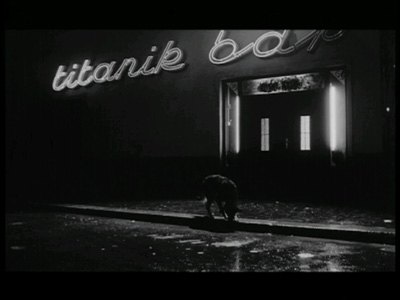
THE DVD
Video:
For the most part, Facets has done a swell job on the picture for Damnation. It's widescreen (no aspect ratio given), and the black-and-white cinematography has nice values. There are only occasional glitches--white pops when the screen goes to black, soft edges or flickering here and there. Given Tarr's regular use of deep focus, though, all the fine points come through. As he moves in and out of different rooms, or as Karrer stares out the window at the scarred landscape, there is never any loss of detail.
Sound:
Ditto on the sound mix. There is nothing fancy listed on the box, but given how much is going on with sound throughout Damnation, I found what I was hearing to be impressive. As with the movement of Tarr's camera, the soundscape shifts as we move from room to room, conversation to conversation. The mix sounds natural, just as it would to our ears if we were physically traveling through the same areas. Given all the industrial ambience that is a constant throughout the picture, the sound engineer has also been careful to layer the bits and pieces, creating a constant throb that the viewer, like the stranded and desperate people they are watching, never quite becomes acclimated to.
Extras:
None on the disc, though Damnation does come with an informative booklet with liner notes. Facets hadn't included it with the screener, so I tracked one down after I had written my first draft. Imagine my surprise when I discovered it's titled "A Cinema of Patience." Great minds thinking alike, or a broken clock being right twice a day? Either way, the book has background essays on Béla Tarr and an interview with the man himself.
FINAL THOUGHTS:
Recommended. Damnation is a thoughtful, rewarding film that stays with the viewer long after the credits have rolled. Each new viewing is likely to reveal new layers of its subtle story. Given that it's a film that is meant to be dug into and explored, however, it would have been nice had the DVD come with some extras on the actual disc that did just that; still, that simply means the joy of discovery is all our own.
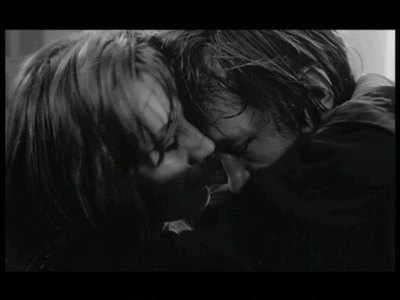
Jamie S. Rich is a novelist and comic book writer. He is best known for his collaborations with Joelle Jones, including the hardboiled crime comic book You Have Killed Me, the challenging romance 12 Reasons Why I Love Her, and the 2007 prose novel Have You Seen the Horizon Lately?, for which Jones did the cover. All three were published by Oni Press. His most recent projects include the futuristic romance A Boy and a Girl with Natalie Nourigat; Archer Coe and the Thousand Natural Shocks, a loopy crime tale drawn by Dan Christensen; and the horror miniseries Madame Frankenstein, a collaboration with Megan Levens. Follow Rich's blog at Confessions123.com.
|
| Popular Reviews |
| Sponsored Links |
|
|
| Sponsored Links |
|
|
| Release List | Reviews | Shop | Newsletter | Forum | DVD Giveaways | Blu-Ray | Advertise |
|
Copyright 2024 DVDTalk.com All Rights Reserved. Legal Info, Privacy Policy, Terms of Use,
Manage Preferences,
Your Privacy Choices | |||||||









